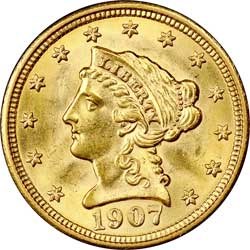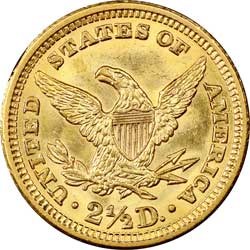USA Coin Album: A Golden Favorite
Posted on 4/9/2019
Collectors are fond of assembling "short sets" of United States coins. These are subsets within an overall series that don't include rare issues that would inhibit completion. Popular short sets include Mercury Dimes 1941-45, Buffalo Nickels 1934-38 and Walking Liberty Half Dollars 1941-47. This is a fun and affordable way to enjoy some of our most beautiful coins.
There aren't many short sets among America's gold coinage, but one of them is the Coronet Liberty Quarter Eagle series of 1900-07. This run includes just a single mint (Philadelphia), and there are only eight coins, all of them priced in a narrow range across most grades. There's a story behind why so many of these pieces have survived in Mint State all the way up to the Gem level (MS 65 and higher), and it makes for an interesting bit of numismatic history.
 |
 |
| 1907 $2.50 Click images to enlarge. |
|
The Coronet Liberty Quarter Eagle was the last denomination to receive this design, which was created by Christian Gobrecht and debuted on the Eagle in 1838. It was adapted to the Half Eagle the following year and finally was reduced for use on the diminutive $2.50 piece in 1840. Struck at five different mints prior to America's Civil War, three of those mints closed in 1861. Both Philadelphia and San Francisco continued production of these coins during and after the war, but the last S-Mint edition was issued in 1879. Thereafter, only Philadelphia struck Quarter Eagles through the end of the Coronet Liberty series.
Fairly large numbers of this denomination were produced in 1878-79 for a very specific reason: United States paper money, which had depreciated during and after the war, finally achieved value parity with gold coins at that time. In anticipation of this development, all gold denominations were produced in much larger quantities than usual. As it turned out, Americans were perfectly content to use paper notes in place of the coins, knowing that the latter were available at face value when desired. Mintages plunged after 1880 and, for the three smallest gold denominations—$1, $2.50 and $3—remained low throughout that decade. These coins were all but invisible in circulation, as Mint Director Edward O. Leech observed in 1889:
With regard to the three-dollar gold piece, it may be said that the denomination of coin serves no useful purpose, and that its present coinage is limited to Proof coins [he was mistaken in this] sold at a profit by the Mint to meet the demands of numismatic societies and coin collectors. There is no demand for it by the business public.
The same objections apply to the one-dollar gold piece, with the additional one that it is too small for circulation, and that the few pieces issued annually from the Mint are used almost exclusively for the purposes of ornament. So long as statutory authority exists to coin this latter denomination, the suspension of its coinage by the Secretary of the Treasury is of doubtful legality. The most he has ever felt warranted in doing was to limit its coinage to pressing demands about the holiday season, and to maintain, unbroken, the series of coin sets sold by the Mint. The very limitation of its coinage leads to favorites in the distribution of the few pieces struck annually and to speculation in them.
As the 1890 holiday season approached, and people began clamoring for gold dollars and three-dollar pieces of the current year for gift-giving purposes, Congress finally acted by passing a law on September 26 that eliminated these denominations, as well the equally useless three-cent piece. In anticipation of this new law, none of those coins had been produced during 1890.
Frustrated by the lack of annual small denomination gold coins to present as holiday gifts and other mementos, the public began turning its attention to the Quarter Eagle as the new coin of choice for special occasions. Among those receiving a Quarter Eagle as a gift was the famed coin dealer Abe Kosoff, who years later recalled being given one for his bar mitzvah around 1926.
Production of this denomination, which was rarely seen in general circulation, was limited to the final months of each year, and mintages steadily rose during the 1890s. This trend accelerated rapidly starting in 1900, as the novelty of a new century resulted in higher demand for all coins bearing that date. Mintages continued to grow until 1907, when the production of Quarter Eagles nearly doubled over the previous year.
It was known that a new design was under consideration for 1908, and it's likely that collectors had a speculative interest in the final year of this venerable coin type. Already, Quarter Eagles were trading at a premium and were sometimes difficult to obtain from banks. Though no longer available for current years, the Coronet Liberty type still was preferred over the Indian Head design which replaced it.
When laws ending gold coinage and restricting its ownership were passed in 1933-34, collectors were limited to holding only pieces that were of recognized numismatic value. In addition, an exception was made for the Quarter Eagle, ownership of which was unrestricted. Congress recognized that this coin had a long tradition as being the subject of presentations, and it did not want Americans to have to surrender their cherished keepsakes. Even today, Indian Head Quarter Eagles and Coronet Liberty Quarter Eagles dating from the mid-1890s and later remain plentiful in Mint State grades. As so many were preserved from their time of issue, there are also a far greater number of Gems than one would expect of circulating coins.
David W. Lange's column, “USA Coin Album,” appears monthly in The Numismatist, the official publication of the American Numismatic Association.
Stay Informed
Want news like this delivered to your inbox once a month? Subscribe to the free NGC eNewsletter today!
